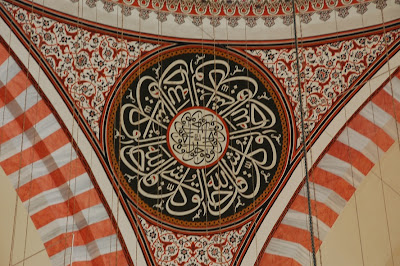Calligraphy
Islam forbids images that represent living beings. So for centuries mosques and holy writings have been decorated with calligraphy and geometric patterns instead of statues or paintings as in the West. Sometimes in both sacred and secular art, words and letters themselves are fashioned into lovely designs, which we find particularly pleasing. (Click here to see some.) The most famous calligraphy may be the emblem of Süleyman the Magnificent (1494-1566), which he used as a logo or seal on official documents. Here is another version.
Metro
There’s only one subway from the center nearby to the north, where millions of people live. (There are other Metro lines elsewhere but, inconceivably, they don’t connect.) Because this line was recently rebuilt, it’s a total delight. No graffiti (unlike Paris), escalators and elevators at every stop (unlike Paris), so smooth and quiet we wondered if we were moving (ditto) and unambiguous signage also in English (ditto). In both directions one day, people gave us their seats and in good English offered us navigational help and conversation (ditto). Next up, the ferry system.
Our bigger realization is that in a rapidly developing city like this, anything new, not just the subway, might be dazzlingly up-to-date. Like the eleven-level indoor shopping mall we just discovered up near Elsa’s cooking class, complete with a seven-screen movie complex at the top (boasting “Ferrari seats,” whatever they are). It’s a very very sophisticated place indeed, exhibiting not just excellent Turkish but world-class design.








No comments:
Post a Comment